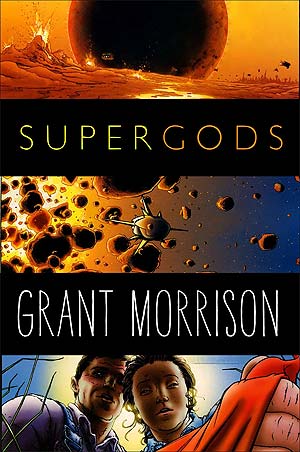
Holy Texts, Wholly Heroes
Two new books explore superheroes and religion
by Aaron Ragan-Fore
 |
 |
Sometimes it takes a little love from another culture to make us all appreciate something we think of as uniquely American. The Japanese first started picking up baseball bats in the late 1800s. Paris embraced jazz in the 1920s. And the late 20th century saw an influx of British, Scottish and Irish creators refining, reworking and reinterpreting American comic book superheroes.
The tights-and-capes set comprise a telling element of the American psyche, and now two natives of the British Isles have each produced a book examining the conception and execution of the American superhero characters they admire.
Ben Saunders, a professor in the UO English department, was guest curator of the Jordan Schnitzer Museum’s 2009 exhibition of superhero comic book art (see “Affection and Nostalgia,” 9/24/09). His new book, Do The Gods Wear Capes?: Spirituality, Fantasy, and Superheroes, (Continuum, $21.95) posits that “superhero comics are especially, generically, suited to the task of engaging, expressing, and addressing urgent and ethical existential questions.”
Do The Gods Wear Capes? features a cover illustration by Oregon comic book creator Michael Allred that depicts a caped superbeing with the symbol for infinity emblazoned on his chest. It’s an appropriate crest for a book that expounds on hero characters as workhorse metaphors for inner struggles and psychological concepts.
Saunders suggests that Superman, for example, offers his readers an adaptable conception of virtue that changes per context, a series of “different ideological formations that alter almost by the decade, and in accordance with broader historical contexts: from thinly veiled revolutionary socialism to wartime populism to Eisenhower capitalism to self-canceling escapism to inhibiting self-skepticism.”
Saunders applies a similar degree of scrutiny and interpretation to other popular hero characters, identifying in Wonder Woman comics themes of loving submission; in The Amazing Spider-Man, the struggle to operate as an actively moral being; and in Iron Man, questions of humankind’s role in a world supported by technology.
Saunders utilizes anecdotes from his own life in his scholarly manuscript to illustrate and expand upon the ideas he puts forth, such as an evolution from his boyhood opinion that the ethically superior Superman is dull and boring, to an appreciation of the character’s unshakable virtue as part and parcel of his “mythic significance” for readers.
Scottish-born comics writer Grant Morrison (All-Star Superman, The Invisibles), meanwhile, has penned his own treatise dealing in large part with the question of comic book characters as representatives of the divine, but to quite different effect. Morrison’s sprawling and multifaceted Supergods: What Masked Vigilantes, Miraculous Mutants, and a Sun God from Smallville Can Teach Us About Being Human (Spiegel & Grau, $28.00) is long on anecdote but a bit shorter than Saunders on substantiated academic theory.
Morrison, who now and then cites the work and influence of Eugene favorite son Ken Kesey, structures his book as part history of the comic book form, part personal memoir, and part statement of personal and religious belief. Morrison, a modern practitioner of magic, lays out the origins and major precepts of his religion of one — a heady mix of drug use, visits by spiritual beings, performance of mystic rites as well as characters and concepts he readily identifies as fictional pop-cultural constructs.
In perfect keeping with our ironic times, the era of the reality show as professional and public self-reflection, Morrison has literally incorporated into his beliefs a niche for the comic books — the “radical enhancement of the mundane” — that he writes for a living.
“I had no need of faith,” Morrison writes in a characteristically bold and bizarre passage. “My gods were real, made of paper and light, and they rolled up into my pocket like a superstring dimension.”
The book is a catechism for Morrison’s acolytes, of either the spiritually devout or comic book fanboy varieties. It’s as if Morrison, flying high and prepping for a Mideast pilgrimage, skimmed Saunders’ book while packing and decided to take the title literally… despite the fact that work on the two books was undoubtedly underway at the same time.
The two works dovetail nicely, for all their differences in approach, style and material. And the nifty thing about the two is that, if your personal reading docket has room for just one tome devoted to comics studies, you can exercise a choice between a taut and nuanced academic work by one of our most important comic book scholars, and a personal statement of gonzo belief by one of our most important comic book creators.